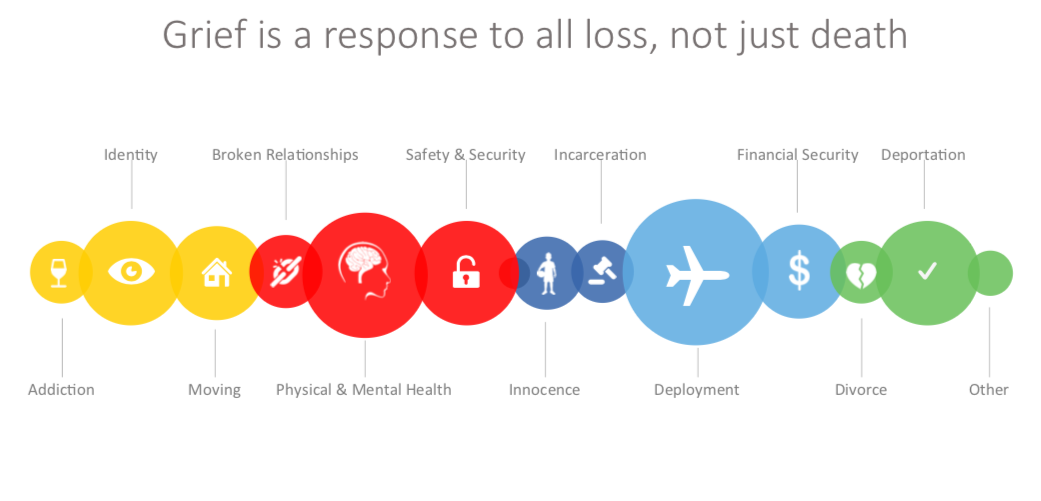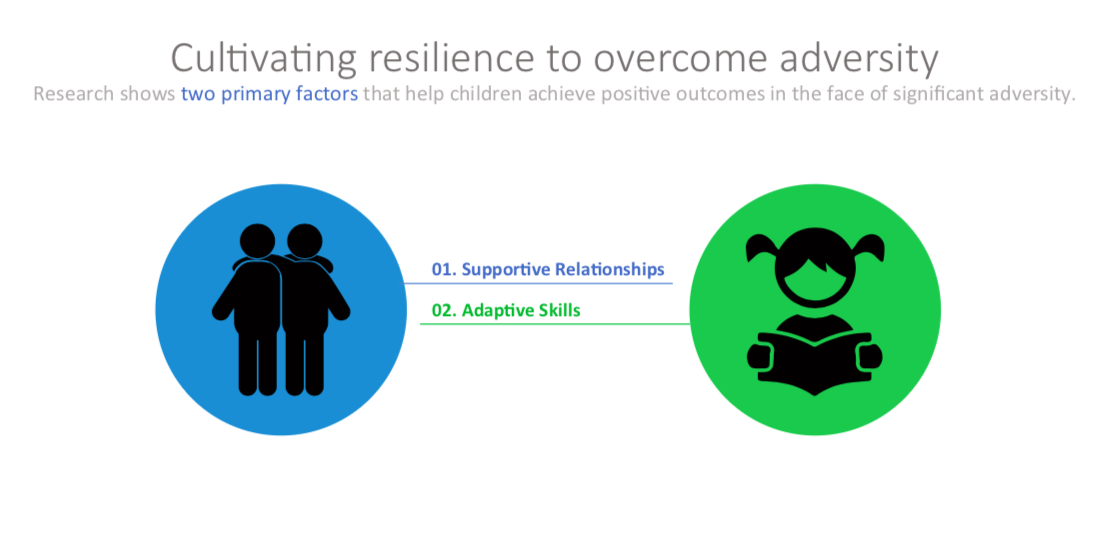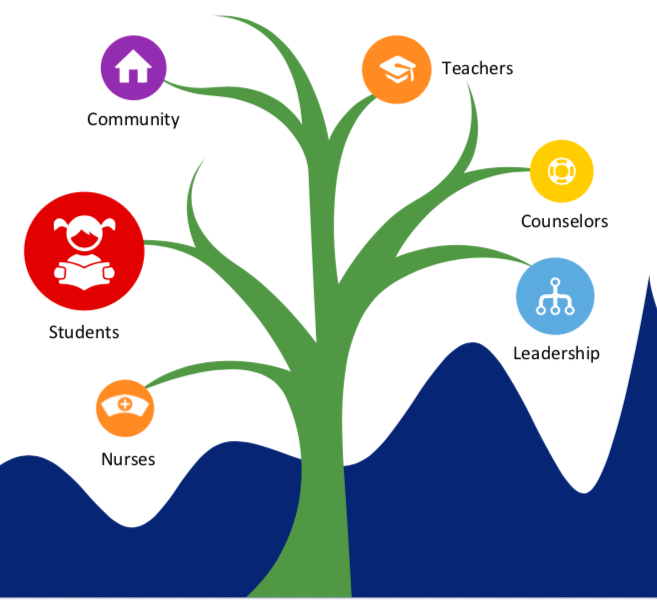Summary
One hundred percent of students will grieve and face adversity. Very few students, though likely none, will receive education on this complex and contradictory emotional response that permeates life. Grief is a response to adversity, and therefore the catalyst of many risk factors. However, supportive and responsive environments mitigate the majority of risks associated with grief, necessitating education that promotes prevention and emotional agility. Schools are chief among the critical places that influence a child’s outcomes and resilience. In order to promote more resilient environments, Good Grief, Inc. is mobilizing its greatest ambassadors to change our dysfunctional culture and promote grief resilience curriculum: grieving parents.
Article
Grief is normal. It’s a part of being human and it serves an important role in how we process and respond to life’s hardships and adversities, including death. Grief does not discriminate and it effects every race, culture, age, and demographic. In our experience, the majority of adults, however, struggle with talking about grief and loss to children. Most do not know how to adequately and meaningfully meet children’s psychosocial needs after a child has experienced the death of a loved one. Few know the route towards a child’s resilience. Instead, most respond to children and teens with clichés and euphemisms rather than honesty, education, empathy, and surrounding them in a supportive environment.

Parents of grieving children have a different perspective than their peers. They experienced a devastating loss and are often hyper-focused on their child’s emotional well-being. These parents know firsthand that the death of a parent or sibling exposes their child to risks such as isolation, bullying, toxic stress, obesity, and much more.1 As a result, Good Grief has mobilized its grieving parents to help better fulfill its mission.
For the past 14 years, Good Grief has provided support to grieving families, advocated for the needs of children, and provided education to professionals working with children and families. Over the years, schools have invited us to present our educational content to faculty and administrators. Most invitations come after the death of a student or teacher, sometimes a parent, and on rare occasion, a suicide. Intervention after a death is important work. But, changing a dysfunctional culture that promotes unhealthy responses to grief requires prevention well before an intervention is needed.
In 2015, Good Grief reviewed the literature on childhood bereavement and launched The Whole Child Initiative.™ We concluded that a comprehensive, 360 degree approach to prevention is the best way to support grieving children. One challenge has been education. While many excellent administrators and teachers understand the need for grief and resilience training and eagerly work with us to provide it to their students and faculty, others prefer to pretend that death won’t strike their population -- of course, until it eventually does because it always does -- and many prefer to broach this subject after a tragedy. From our experience, this fear is simply because a comprehensive, digestible, and non-threatening curriculum has not previously existed. Few tools have been provided to meet educators’ needs, help them see grief differently, and ultimately teach resilience. But, that’s about to change and Good Grief parents are helping lead the way because they know their children’s health is at stake.
Parents within our program understand that when little Timmy returns to school after the death of his father, he will have diverse needs.

A grieving student needs a consistently supportive and responsive environment; something that cannot be built overnight in reaction to tragedy. Education and resilience need to be developed well before death arrives. Research supports the need for prevention by identifying four areas where grieving children are most vulnerable: 1.) home, 2.) community/culture, 3.) peer-group, and 4.) school.2 In other words, grieving children are vulnerable everywhere because their environment shapes their outcomes. From Good Grief’s vantage, the most urgent opportunity to develop their resilience is at school -- the environment where a child learns and plays.
While piloting of our curriculum, Routes to Resilience, 78 percent of students said they experienced grief through some form of adversity and no students reported any education provided to them on grief. Given that grief is a universal component of the human condition, there is a very real and apparent gap in education on the language, knowledge, and coping strategies necessary to prevent unhealthy outcomes after experiencing grief and loss.

Grief changes a child’s worldview. It changes a parent’s perspective, too. This new reality encourages parents to get resources to both their children’s peers and teachers because parents can see that both impact resilience. Our advocacy efforts simultaneously support these pursuits. In order to educate the adults in the lives of children, Good Grief collects the names and contact information for our participants’ teachers, administrators, coaches, clergy, and other relevant adults. Quarterly, we send educational materials to these constituents, knowing that they play a direct role in Good Grief’s success with children. Additionally, our resources help develop a partnership between parent and teacher because, as a third party, we have provided them with the tools and opportunities to be involved in the dialogue about the child. As the connection between parent and teacher grows, fear decreases and our parents are able to encourage teachers and their boards of education to implement Good Grief’s curriculum.
By giving the parent tools to advocate for their child and other children, Good Grief is also giving parents an opportunity to make meaning out of their grief and take control of their situation during a chaotic and disempowering time in their lives. Similarly, we are personalizing a subject that so many Americans avoid or are not equipped to address.
Seed money from two family foundations made the pilot and preliminary implementation of our curriculum possible. While our programs are free of charge to our families, the cost of implementing the curriculum, coaching, and training is $10,000 per school. Most schools, of course, cannot afford this necessary investment.
Unfortunately, the message and data around childhood bereavement, grief, and resilience has not been adequately amplified. As a result, the risk factors grieving children and their families face are not on the radar of most foundations, including ones with a focus on health, children, or education. Our culture’s dysfunctional response to grief is imbedded in who we are as a people and the decisions we make from education to philanthropy to wellness. By not providing children with resources, we are not providing them with the tools they need to be more resilient. We see our work at Good Grief, in part, as taking responsibility to amplify this information and educate our schools and communities on the need and importance of this work.
What happens in childhood affects adulthood. We know that supportive relationships and adaptive skills are needed for resilience, but supportive relationships require informed peers and teachers. Resilience is built, not inherited, but we are short the necessary mechanics -- in the form of funders -- to rebuild the engine. While grief and loss are not preventable, the risk factors can be upended with the proper education and support. Luckily, Good Grief knew to empower its parents, who have a powerful and personal story to tell. Good Grief’s families are adapting to life after loss and demonstrating not only the urgency of the need, but are acting as role models for what is possible when support and education are adequately provided: resilient parenting, adaptive coping skills, and the normalization of grief itself. This is the route to resilience for children and parents alike.
1 Akerman & Statham, 2014; Center on the Developing Child, 2007; Gaffney, Kaplow, Layne, & Primo, 2016; LaFreniere & Cain, 2015a; Layne, Briggs, & Courtois, 2014; National Scientific Council on the Developing Child, 2005/2014; Shonkoff, 2012
2 Knudsen, Heckman, Cameron, & Shonkoff, 2006; National Scientific Council on the Developing Child, 2005/2014; Shonkoff, 2012, p. 17303


